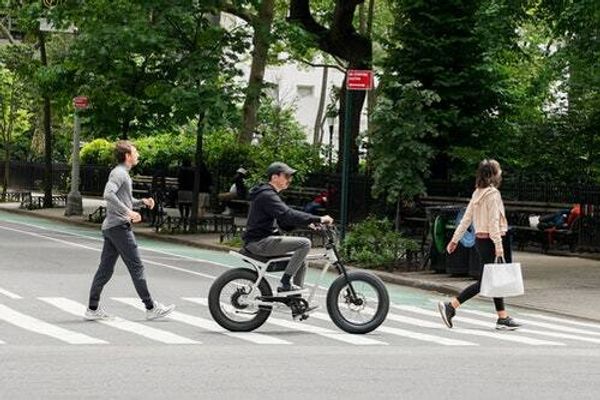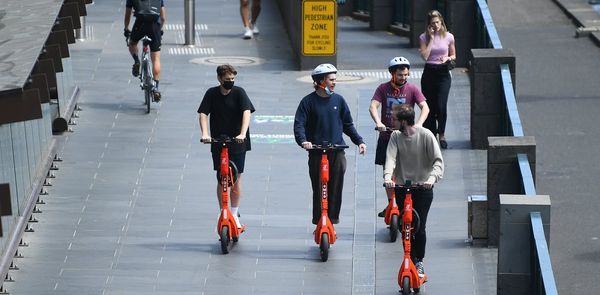
Grace Dowling remembers the day e-scooters arrived in Melbourne. She was working at a pub on Brunswick Street until the early morning. When she emerged, “It was like Chicken Little.”
“There were hundreds,” she says.
Since Victoria’s 12-month e-scooter trial began in February, Dowling estimates she has taken more than 100 trips. Scooting is safer than walking home late at night, and a ride home costs about $3, much cheaper than an Uber.
Dowling says she loves it not just for convenience, but for fun – it’s impossible not to look daggy on one.
“My housemate and I once rode home listening to We Can be Heroes on her UE Boom [portable speaker],” she says.
E-scooters have exploded in popularity since the rental company Lime launched in Brisbane at the end of 2018. The company now operates 3,500 e-scooters across Australia and New Zealand, and has been joined by competitors Beam and Neuron.
But they remain subject to messy regulatory frameworks across states and territories, as well as opposition from groups representing pedestrians and people with disabilities.
Queensland, the ACT, Western Australia and Tasmania have the most scooter-friendly rules, allowing share schemes and privately owned e-scooters to be ridden in public.
In Victoria, South Australia and the Northern Territory, e-scooters are only allowed at selected trial sites with restrictions on privately owned devices, while New South Wales is the only state yet to have mandated e-scooters in any form – which has not prevented many users from buying and riding them.
Its first trial of a rental scheme is slated to begin in 37 councils later this month, but City of Sydney and Inner West councils have declined to participate, citing safety concerns for pedestrians.
Inner West council says it is “keen to see the results of the trial before making further decisions”, while Sydney lord mayor Clover Moore says the state government should “get the regulation right” before e-scooters are encouraged in the “contested space” of the CBD.
Simple laws should be passed to allow private owners to utilise their mode of transport
“The data from emergency departments both nationally and internationally on e-scooter injuries is sobering,” she says. “The risks, not just for riders but for pedestrians, especially people with disability and the elderly, are obvious.”
There is no national database on e-scooter crashes, but there have been at least three deaths since 2018, including two in Western Australia and one in Queensland this month when a 15-year-old boy died after a crash in Logan, south of Brisbane.
Data from the Jamieson Trauma Institute found of 952 e-scooter emergency department presentations in Brisbane over a three-year period, the most common injuries were fractures and abrasions to the head and face.

Alcohol use was documented in 29% of presentations, and speeds above 20km/h were reported in more than one-third.
Amy Schramm, of the Centre for Accident Research and Road Safety at Queensland University of Technology, says comparing the danger of e-scooters to other forms of transport is impossible in Australia due to lack of data. But international studies suggest there are about 115 serious injuries per million e-scooter trips, a rate comparable to motorcycles.
A study undertaken by the centre in 2019 found e-scooters were ridden illegally on about half their journeys, and riders using share schemes were more likely to be non-compliant.
Micro-mobility companies use advanced technology to enforce local laws, including automatic speed control, geofencing, voice guidance and using individual QR codes to track riders.
Neuron says there are fewer than two incidents per 100,000km travelled on their devices that require inpatient treatment, while Beam reports fewer than one out of 100,000 trips result in severe injury. Lime says more than 99.99% of rides are completed safely.
In June, the Queensland transport minister, Mark Bailey, released new rules to regulate e-scooter use, while reiterating they “weren’t going anywhere”.
After the tragic event of the teenager’s death, he said: “This technology is here to stay, but we need to continue to adapt the framework that supports these devices to ensure everyone’s safety, particularly people with disabilities.”
The Queensland Disability Network has been working alongside the state government after citing concerns over parking hazards and e-scooters ridden at high speed on footpaths. Its chief executive, Paige Armstrong, says “further discussions need to be had” to minimise safety risks.
The changes include speed limits on some footpaths, mandating bells and increasing penalties for high-risk offences, with long term goals to improve parking and signage and build better transport infrastructure.
The speed limit on Queensland footpaths will be halved to 12km/h from 1 November.
‘Pointless trial’
Electric Riders Australia, a peak body for mobility users, says Queensland has led the way in regulating e-scooters, alongside the ACT – which legalised the devices for private use in 2019.
Its chief executive, Tom O’Neill, is lobbying for private e-scooters to be legalised in every state and territory.
“Though our community acknowledges the step forward with the commencement of the NSW e-scooter trials, there’s a large proportion [of users] … that privately own a device who are excluded,” he says.
Prohibition in NSW has not stopped many users riding e-scooters, which are everywhere to be seen on the streets of Sydney and elsewhere in the state.
Mark, who didn’t want his surname used, has operated a private electric scooter in NSW for about four years, racking up just shy of 7,000km.
“I’ve known from the start that such devices are illegal … and seen outcomes ranging from verbal warnings, all the way through to near $3,000 fines,” he says.
Australia is behind the rest of the world when it comes to e-mobility
Mark says the benefits are clear: carbon emission reductions, cost of living benefits amid petrol price hikes, preventing infrastructure wear.
He says he is “angry and embarrassed” that the NSW government refuses to legalise private scooters before regulating hired ones, and at the “bureaucratic senselessness” of rolling out another state-specific trial.
“They continue to delay and procrastinate the decision … to run this pointless trial,” he says.
“To do so ahead of privately owned devices is utterly misguided. [Rental scheme] users are allowed … to jump on and use the scooters with nothing but a few app screen’s worth of theoretical instruction and guidance.”
Norman Dee agrees. He rides an e-bike around the Melbourne CBD and its surrounds, and says the problem with e-scooters is inexperienced riders.
“People who own their scooters pay very good money for their mode of transport,” he says.
“Simple laws should be passed to allow private owners to utilise their mode of transport rather than allow people who are inexperienced … to hire them.”
‘The demand for micro-mobility is only growing’
Madison Bland, a PhD candidate at Griffith University’s Cities Research Institute, says there are “big caveats” for the NSW trial, particularly as riders will be banned from using footpaths, preventing the take-up of already existing safe infrastructure.
“It’s a conversation state and local governments need to have if we’re going to be dabbling into alternate shared micro-ability options,” he says.
“Either we start converting or reprioritising road space for other devices or start looking at lower speed limits to make the road environment safer.
“If we are realistic in combating the climate emergency we have to look to these more sustainable modes … we can’t just convert our cars to electric vehicles and expect that to solve the problem.”
Bland says the benefits of e-scooters are multifaceted.
“As soon as electricity grids transition, e-scooters will be carbon neutral. We can look to them as part of a breadth of sustainable transport modes … one important factor of many,” he says.
“They’re perfect for those short, inner metropolitan trips. And with rising fuel prices, e-scooters provide a cost-effective device.

“But there’s also the fun factor, which is why they’re strongly outcompeting a lot of other modes of transport.”
Beam, which launched in Singapore and now operates in 25 markets across Australia and New Zealand, says it has been carbon neutral since 2019.
“The demand for micro-mobility is only growing across Australia,” general manager Tom Cooper says. “Each e-scooter we deploy on the streets [is] used over four times a day on average.”
“Amongst regular riders of Beam … 75% say they use their car less as a result of access to shared e-scooters. Of riders who already live the car-free lifestyle, 21% sold their car as a direct result of having access to shared e-scooters.”
Neuron – the only micro-mobility company to operate in every Australian capital – has similar findings. A spokesperson for the company says , 40%-55% of e-scooter trips replace car journeys, depending on the city.
Richard Buning, a senior lecturer at the University of Queensland, researches how tourists use e-scooters. He has found the devices, next to walking and ride-share, are the most popular way to get around a city.
“They’re really winning in terms on convenience, price and ease of use,” he says.
“When tourists use e-scooters, they become more widely dispersed. Rideshare is point to point – you’re missing everything in between. But just a quarter of e-scooter rides start and end in the same location. It’s the ideal way to experience an urban area as a visitor.”
As for safety, Buning says providers have a large role in conveying local policy, while governments need to improve infrastructure and signage.
“The holy grail would be bikeways to get around cities, better parking areas, dedicated signage,” he says.
“The bottom line is this isn’t going anywhere. It’s becoming more and more popular, and Australia is behind the rest of the world when it comes to e-mobility.”










